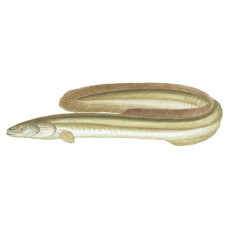Latin name
Anguilla rostrata
Other names
Silver eel, Atlantic eel, common eel, yellowbellied eel, freshwater eel, bronze eel, water snake, whip; Dutch: amerikaanse aal; Finnish: amerikanan kerias; French: anguille d’Amerique; Italian: anguilla americana; Japanese: unagi; Portuguese: enguia-americana; Spanish: anguila, anguila americana; Swedish: amerikansk ål.
Identification
The body is elongated and snake-like, with a pointed head and many teeth. It is covered in thick slime, hence the expression 'slippery as an eel'. The large mouth extends to the centre of the eye or beyond. There is a single gill hole just in front of the pectoral fins. There are no pelvic fins and the dorsal, anal and caudal fins with soft rays form one continuous fin. There are no visible scales. Colouration changes with maturity.
Distribution
The American eel is found from south-west Greenland to Labrador, south along the North American coast to Bermuda, the Gulf of Mexico, Panama and the Caribbean. Within this region, it is found inland from the mouth of the Mississippi River in the east and north-east to the Great Lakes and the Atlantic Ocean.
Habitat
American eels are catadromous, spending most of their lives in fresh water and returning to salt water to spawn. They prefer to live in dense vegetation or burrow into sandy bottoms. Their physical structure is such that they can easily swim backwards and bury their tails in soft bottom sediments.
Size
American eels grow to 50 inches and 16 pounds. The average size of adult females is about 3 feet, while adult males are much smaller, rarely exceeding a foot in length. They can live for over 9 years in rivers, streams and lakes.
Life history and Behavior
When it is time to spawn, males and females stop feeding, change colour from olive to black and head out to sea. Eels spawn in the same area of the Atlantic Ocean, in deep water at the northern end of the Sargasso Sea. Each female lays 10 to 20 million eggs and both sexes die after spawning. The eggs float to the surface and soon hatch into thin, transparent larvae (glass eels). The sex of the eel is thought to be partly determined by environmental conditions such as crowding and food abundance, but this is not determined until the eel is 8-10 inches long and living in its freshwater habitat. Larvae drift and swim with ocean currents to estuaries for 1 year. Males remain close to estuaries while females migrate upstream, usually at night. Eels can absorb oxygen through the skin as well as the gills and are known to move around on land, especially in wet, rainy weather. Tangles of intertwined eels have been seen rolling along beaches in search of fresh water to overwinter in.
Food and feeding habits
The diet of nocturnal American eels includes insect larvae, small fish, crabs, worms, mussels and frogs. They will also feed on dead animals or fish eggs and are capable of tearing off smaller pieces of food that are too large to swallow whole. Their eating habits are rather unusual compared to larger prey. These eels have relatively weak jaws, mainly adapted for grasping, but they also have many small, round and rather blunt teeth. Because they are palindromic, meaning they can move forwards or backwards with equal force, they are able to pull, twist and turn, tearing apart prey that is too large to be eaten whole.
Reproduction
No information
| Classification | |
| Phylum | Chordata |
| Class | Actinopterygii |
| Squad | Anguilliformes |
| Family | Anguillidae |
| Genus | Anguilla |
| Species | A. rostrata |
| Features | |
| Conservation status | Endangered |
| Habitat | Bottom |
| Life span, years | 9 |
| Maximum body weight, kg | 7.26 |
| Maximum length, cm | 91.44 |
| Sailing speed, m/s | No information |
| Threat to people | Edible |
| Way of eating | Predator |




